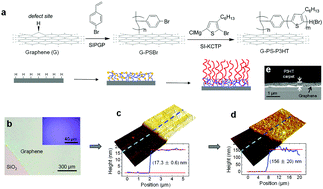Bottom-up fabrication of graphene-based conductive polymer carpets for optoelectronics†
Abstract
The covalent attachment of one dimensional (1D) polymer brush onto a two-dimensional (2D) material presents an appealing strategy to fabricate anisotropic polymer membranes, namely “polymer carpets”. Conductive polymer carpets that are based on graphene and conductive polymers are especially interesting due to their potential in microelectronics, actuators and optoelectronics. Here we describe a versatile method for the covalent grafting of the poly(3-hexylthiophene) (P3HT) brush onto large area graphene to fabricate conductive polymer carpets through a combination of photografting polymerization and Kumada catalyst transfer polycondensation (KCTP) to grow P3HT (up to 260 nm) on single layer graphene forming conductive polymer carpets (i.e. G-PS-P3HT). Raman mapping revealed that the grafting reactions occurred on native graphene defects, without deteriorating the conjugation plane of graphene. The advanced architecture of G-PS-P3HT resulted in a high photocurrent (ca. 0.3 mA cm−2) under light irradiation in a junction with MoS2 to form efficient an p–n heterostructure, with promising potential in optoelectronics.



 Please wait while we load your content...
Please wait while we load your content...